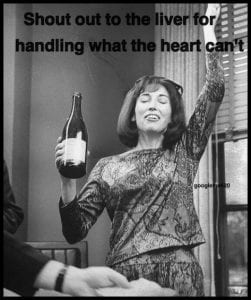Alcohol use among women has been increasing at an alarming rate. In fact, according to the JAMA Psychiatry article published in September 2017, there was a 34% increase in high-risk women drinkers and alcohol use disorder (AUD) from 2002 to 2013 compared to a 13% increase in men. This demonstrates that alcohol use among women is a growing public health issue that needs to be addressed. However, with the media, marketing strategies employed by alcohol companies and the normalization of alcohol in our society, addressing this issue is becoming increasingly harder to do.
There are several ways that women are targeted by both the media and marketing strategies which appeal to them to drink. One of the best-known examples of this is the wine company, “MommyJuice”. The marketing strategy behind this brand is that it is stressful to be a mother – to juggle taking care of yourself, your kids, and work – and that even moms need a way to unwind. And what a better way to de-stress than with a glass of MommyJuice? While moms do work incredibly hard (and absolutely need to take time for themselves), is encouraging them to relax with alcohol the best way? Especially when it’s branded in such an insidious way, it appears to be taking advantage of women and their situations.
It is common for kids to have playdates, and while the kids are playing so are the parents who use this as an excuse to socialize and drink. There are potential consequences that can result from an afternoon of drinking such as the safety of both the adults and children and the normalization of alcohol. After the play date, the mom might have to drive herself and her children home. If her inhibitions are impaired from the “mommyjuice”, the potential for car accidents increases. The act of moms drinking during a child’s playdate can also normalize alcohol for the child. If they are constantly around it as a child because their parents drink in front of them, they may be more likely to drink in adolescence and adulthood.
Another example is the Skinnygirl Cocktail line, with the advertising campaign of “Drink Like a Lady.” The marketing strategy here is that women can still drink but without the worry of extra calories. This will appeal to women because of the societal norms regarding appearance. The other day I saw an advertisement for spiked sparkling water – with only 100 calories, the can reads. I was shocked that an innocent beverage such as sparkling water now needs to be spiked to be enjoyed. Even beer companies have been marketing low-calorie options for women. The reaction the alcohol industry is hoping to elicit from women is, “What’s better than being able to indulge in an alcoholic beverage without the guilt from the empty calories that come with it?” The way these brands are being marketed towards women, many of whom are susceptible to succumbing to them because they address issues that affect women, is manipulative. A quick google search for “low-calorie alcohol” will bring up several articles with suggestions on how to select drinks that will still get you drunk minus the extra calories. Other websites like beer100 offer charts with the caloric content of the different brands of beer. This information is easily accessible, and if the internet says it works, then people believe it.
This leads me into another drinking phenomenon to which I was completely unaware of until recently: Drunkorexia. The name is what it implies; it is a pattern of starvation, excessive exercise or binging and purging in order to consume multiple drinks. This pattern is often seen in women who are concerned about their calorie consumption and body image. Because there is no food in their system, the individual is more susceptible to the effects of alcohol. They will become drunk quicker and are at a higher risk of passing out and of alcohol poisoning. From basic human anatomy differences between women and men, we know that women are more vulnerable to alcohol’s effects. Women tend to have a higher body fat percentage and less body water. Because there is less water in body fat, alcohol is diluted in the blood at a slower rate. Women also have a lower level of alcohol dehydrogenase, which is an enzyme that assists in metabolizing and eliminating alcohol from the body. The bottom line is that women suffer from the effects of alcohol more than men, especially if they are drinking spirits in order to avoid extra calories.
In addition to alcohol companies marketing their products specifically to women, there are several other consumer products that use this as a way to sell products while contributing to the pattern of women and drinking. For example, wine glasses are sold with the mottos “MommyJuice” or “Surviving motherhood one glass at a time” written on them. Cup towels, aprons, magnets, and several other similar products are sold which perpetrate this increasing trend of women who drink. These novelty items are given as gifts, oftentimes as a joke, but they still carry that message that drinking for women is a necessity to cope with the stressors of daily life.
I understand that some people don’t necessarily see this as a problem – they think these products are funny and is meant to be taken as a light-hearted joke or that indulging in alcohol isn’t the worst thing they could be doing – but if they take the time to look at the national trend in high-risk drinking and AUD mentioned earlier, I would hope that they would change their minds. Alcohol companies have noticed this upward trend in the number of women who drink, and are using that information to exacerbate a public health issue. Because drinking is so normalized and engrained within our culture, it is not viewed as a problem and the alcohol industry, unfortunately, takes advantage of this.














